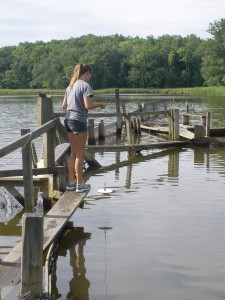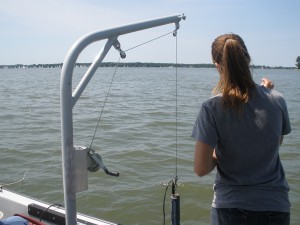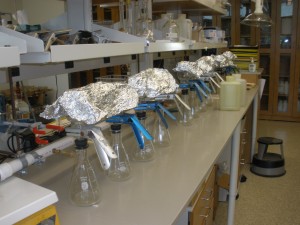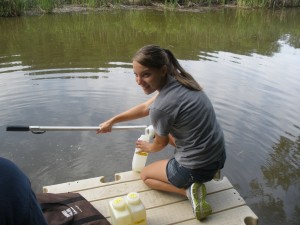By Sarah Hansen

Shelby Paschal, SERC intern, takes the “Secchi depth,” a measure of water clarity, while balancing on the fish weir.
In the Chesapeake Bay region, water quality is a big deal. It can affect populations of economically important animals such as crabs and oysters, or shift ecological relationships among other species. Differences in water quality might even determine whether an invasive species can establish a foothold in the Bay.
But water quality is a nebulous thing. Even collecting water samples can be tricky, something intern Shelby Paschal knows first-hand.
“This is our obstacle course training,” Paschal says with a laugh, after a climbing onto a rickety fish weir at the Smithsonian Environmental Research Center (SERC). Paschal and the rest of the Nutrient Lab, headed by senior scientist Tom Jordan, are running one piece of an ambitious 6-year project studying the effects of multiple factors in shallow near-shore habitats. These critical habitats for small fish, crabs, and plants face threats from invasive species and construction, as well as from degradation of water quality caused by release of excessive nutrients from cropland into the Bay.
The project, now in its fifth year, is funded by the National Oceanic and Atmospheric Administration (NOAA) and is a collaboration of eight different institutions led by SERC. Jordan’s lab is focusing on local impacts: how much do local urban, agricultural, and forested watersheds impact different nutrient levels and water clarity? At their seven test locations in the upper Bay, influx from the Susquehanna River is the dominant factor that determines water quality in the open Bay, but the SERC team is investigating to what extent local watersheds affect adjacent estuaries.
“It’s a very complicated project,” said Paschal, “but also potentially a very useful data set.”
Water quality isn’t something that the researchers can measure in a single step. “It’s not so cut and dried,” said Carey Pelc, lab tech in the Nutrient Lab. It’s very difficult to get a strong handle on all the factors that determine the characteristics of a body of water.

Measurement devices hang off the boat from this pulley system to collect data such as water pH, temperature, salinity, and oxygen level.
At two locations accessible by foot, lab tech Joe Miklas lowers a large, cylindrical tool into the water to measure temperature, salinity, pH and oxygen level. Paschal collects three jugs of water for testing in the lab. A little later, Paschal, Pelc, and lab tech/boat captain Sam Benson take samples from a speedboat hooked up with a pulley system to lower the measurement devices into the water.
From both land and boat, Paschal lowers a white Secchi disk (pronounced “sek-ee”) on a rope into the water, watching carefully until it’s no longer visible. The depth at which it disappears, the “Secchi depth,” measures how well light penetrates the water. This part of the project is relevant to growth of submerged aquatic vegetation (SAV). SAV serves as a natural water filter in the Bay, but it can’t grow without enough light. Depending on the species, SAV needs between 4 and 29 percent of the light available at the surface of the water to grow successfully. This may not sound like a lot, but it’s actually much more than land plants need – many understory shade plants can survive on just 0.5 to 2 percent of the light available at the roof of a forest’s canopy.

These filtration setups in the lab test the water samples for different nutrients, such as phosphorus, nitrogen, and total sediment.
After collecting water samples and taking measurements in the field, the team analyzes the water for nitrogen, phosphorus, dissolved carbon and total sediment content in the lab using specialized filtering techniques for each test. They also use specialized methods to measure light that is absorbed by or bounces off particles in the water samples. The different effects of optical properties and nutrient content in water can be hard to tease out. According to Paschal, “They’re completely hand in hand.”
Pelc said that in the three years she’s been working on the project, years with more rainfall have shown stronger correlations between the local watershed and nutrient contents of the water. In those years, there is more runoff from agriculture operations and city storm water drainage. In drier years, there tends to be more consistency across sites.
Even if she doesn’t love encountering spider webs as she tromps through the woods (“That’s why I’m more of a chemist”), Paschal is excited to be part of such an important project. The team hopes to find correlations in their massive data set that will contribute to a predictive model of water quality in the Bay, which would support conservation efforts on a large scale. Her energy and enthusiasm are also contagious around the lab. “It’s going to be difficult to go back to life without you,” Miklas admits, when she returns to the University of Arkansas this fall.



This is so interesting. I am being exposed to things I have never thought about. It is very important and vital to our survival.
Hal McGhee
That’s my girl! I’m so very proud of you. What an adventure!